LBW is one of the most common ways that batsmen are given out in cricket, and as a result you will hear the term a lot during a cricket broadcast. However, although it’s one of the most commonly used terms in the sport, you’d probably be surprised to see how few cricket players and viewers actually know all of the LBW rules!
For me it was one of the aspects of cricket that took me the longest to understand, but after a few chats with my grandparents (who are massive cricket lovers) and listening to plenty of commentary during live matches, I managed to get my head around it!
If you’re someone who is still unsure what the LBW rules are, then you’re in the right place. In this post I’ll share all of the information you need in order to understand them fully, as well as using pictures to illustrate my examples!
To sum it up simply, the LBW rules in cricket are dependent on the following things:
- Whether the delivery was legal or not
- Whether the bowling side appealed to the umpire for LBW to be given
- Where the ball makes contact with the pitch
- Whether the ball hits the bat
- Where the ball makes contact with the batsman
- Whether the batsman is playing a shot or leaving the ball
- Whether the ball was likely to hit the stumps
I’ll explain all of these in more depth later in the post, but for now we should probably explore what the term ‘LBW’ actually means in a cricket context. Let’s have a look…
What Does LBW Mean?
The term ‘LBW’ stands for ‘Leg Before Wicket’ and it describes one of the ways that a batsman can be dismissed in the game of cricket. Basically, an umpire will give a batsman out LBW if they use a part of their body to block a delivery that would have gone on to hit the stumps. As a result of this law being in place, batsmen are forced to use their bat to block the ball, rather than using their pads or other areas of the body.
A lot of people assume that LBW can only be given when the ball strikes the batsman’s legs – but this isn’t true. The name ‘leg before wicket’ is slightly misleading! A batsman can be given out LBW even if they use their chest, their shoulder, or their head to stop the ball hitting the stumps. LBW is just the name that all of these dismissals would be categorised under.
What Are The LBW Rules?
This is where things get a little more complex! As I’ve already mentioned, being given out LBW is dependent on multiple different factors, and each one must be satisfied in order for the umpire to raise their finger! In this section, I’ll explain each of them in great detail.
Rule 1 – The Delivery Must Be Legal
The umpire cannot give the batsman out LBW unless the delivery is legal and within the laws of the game. This means that the batsman can never be given out LBW if the bowler bowls a no ball.
Rule 2 – The Bowling Side Must Appeal
An umpire cannot give a batsman out LBW unless the fielding team appeals to the umpire – asking them to make a decision.
How should players appeal? If you’ve watched cricket for any amount of time, you will have seen that when a batsman is struck on the pad in front of the stumps, the bowler (along with most of the surrounding fielders) will erupt in unison and shout something like ‘how is that’ towards the umpire. By shouting ‘how is that’ towards the umpire, the fielding team are asking them to make a decision. The umpire will then either raise their finger to indicate that the batsman is out, or decline to raise their finger – meaning the batsman can continue their innings. Take a look at this video here if you want to see some classic cricket appeals!
An appeal can happen any time until the next ball is delivered, but if a batsman is struck on the pad the most impactful time to appeal would be immediately after it has happened!
Rule 3 – The Ball Must Not Pitch on The Leg Side of the Wicket
The umpire cannot give the batsman out if the ball pitches on the leg side of the wicket. If the ball doesn’t bounce before striking the batsman, then you can ignore this rule.
If you’re a right handed batsman, then the umpire cannot give you out LBW if the ball bounces to the left of your leg stump. If you’re a left hander, the umpire cannot give you out LBW if the ball pitches to the right hand side of your leg stump. I’ve included a couple of diagrams of this below so you can see what I mean!
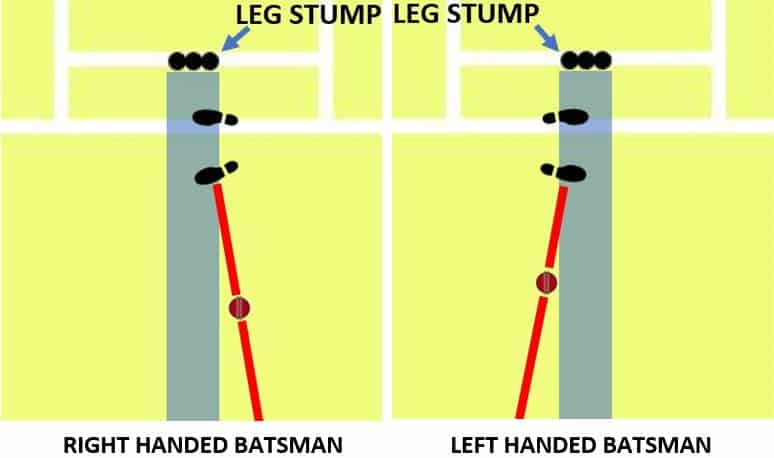
At this point some of you may be wondering what happens when the ball pitches half in line with the leg stump and half outside the leg stump. In this case, more than half of the ball must be in line with the leg stump for the umpire to give the batsman out LBW. If only a fraction of the ball is in line with the leg stump with the majority being outside leg stump, the umpire should automatically deliver a not out verdict. The diagram below helps to illustrate this.
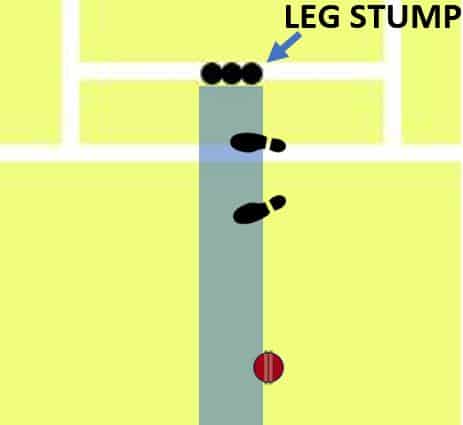
Rule 4 – The Ball Must Not Make Contact with the Bat
If the ball makes contact with any part of the bat or any part of the batsman’s gloves while they are holding the bat, and this happens before the ball hits them elsewhere, the umpire should not give a batsman out LBW. If the ball strikes the batsman anywhere else apart from the bat or gloves, including on the helmet and other protective equipment, the umpire can consider whether to give the batsman out LBW or not.
The text above sums up this LBW rule pretty well. There’s just one thing I need to add! If the ball hits elsewhere on the body before it hits the bat or the glove, then this can also be given out LBW. For example, if the ball hits the batsman’s pad, and then bounces off and hits the bat, the umpire can still give this out as the contact with the rest of the body occurred first. If the first place that the ball makes contact with is the bat or the glove, and then the ball goes on to hit the pad, the umpire should give this not out.
Rule 5 – If the Batsman is Struck by the Ball While Attempting to Play a Shot, the Impact Must Occur in Line With the Stumps
The umpire cannot give the batsman out LBW if the ball hits them outside the line of the stumps while they are attempting to play a shot. If the batsman is not attempting to play a shot, then this rule does not apply. If they aren’t playing a shot and the umpire believes the ball would have gone on to strike the stumps, then they can give the batsman out regardless of whether the ball hits them in line with the stumps or not.
This rule is much easier to demonstrate with some examples. Let’s start with the picture below. The first thing you should notice is that the batsman is attempting to play a shot, so the umpire has to consider whether the ball struck them in line with the stumps. It is clear from the picture that the ball (located in the red circle) hits the batsman’s pad outside the line of the stumps (the blue zone), so the umpire should give the batsman not out.
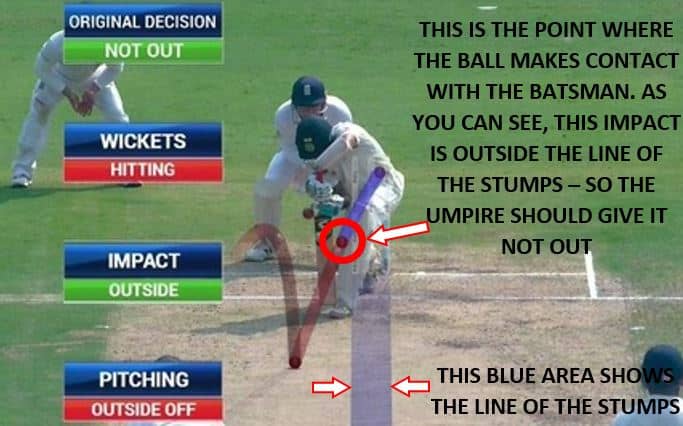
Now for another example. In the diagram below, you can see that that the batsman is attempting to play a shot once again. Unlike the last example, this delivery is in line with the stumps when it makes contact with the pad. This means that if the umpire believes the ball would have gone on to hit the stumps, he should give the batsman out LBW.
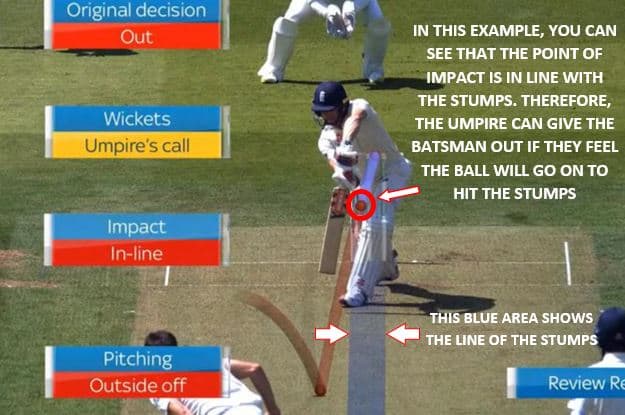
There’s one last example I need to show you, and you can see this one in the picture below. Here, the first thing you should notice is that the batsman is not trying to play a shot, they are attempting to leave the ball. It is clear the batsman has misjudged the delivery and it has gone on to strike them on the pad. You should also notice that the ball has struck the batsman outside the line of the stumps. In this example, due to the batsman not attempting to play a shot, the umpire can disregard the fact that the ball has struck the batsman outside the line of the stumps. All the umpire now has to do is decide whether or not the ball would have gone on to hit the stumps, and give the batsman out LBW or not out as a result.
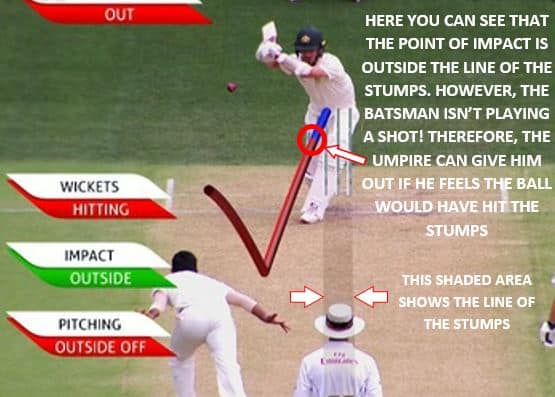
Rule 6 – The Ball Must Be Going on to Hit the Stumps
If the ball strikes the batsman anywhere other than the bat or the glove, and all of the other rules that I’ve mentioned have been satisfied, the umpire must make a decision as to whether the ball would have hit the stumps if it had been unobstructed. If all of the other rules are met, and the umpire feels like the ball would have hit the stumps, they should raise their finger and give the batsman out LBW. If all the other rules have been met but the umpire feels that the ball would have gone over the top of the stumps, or down the leg side, then the umpire should give the batsman not out.
Umpires will usually look for a few things that will give them clues as to how likely the ball is to hit the stumps. I’ll explain a few of them below:
- How high was the ball when it struck the batsman? – The umpire will often use the batsman’s pads as a guide to whether the ball was going over the top of the stumps. If the ball hits the batsman above the knee roll, this is usually a good indication that the ball is too high.
- How far forward was the batsman? – If the batsman got a huge stride in down the pitch and the ball hits them on their front leg, this raises a lot of doubt in the mind of the umpire as to whether the ball would have hit the stumps. The batsman has increased the distance between themselves and the stumps, which means there is a lot more guesswork required from the umpire to give the batsman out. Most umpires don’t like guesswork, so these decisions often go in the batsman’s favour!
- How tall is the batsman? – If the batsman is very tall and the ball hits them high on the leg, there is a high chance the ball will be going over the top of the stumps. The opposite is true for very short batsmen
- Were the stumps visible when the ball hit the batsman? – If the batsman exposed their off and middle stump, and got hit in front of the leg stump, there is a chance that this ball would miss the stumps entirely. On the other hand, if the batsman is stood directly in front of the stumps covering all of them, and then gets hit on the pad, there is a high chance the umpire will give them out LBW.
- Was the ball swinging/spinning a lot? – If the ball had swung or spun a long way before it made contact with the batsman, it is likely that this movement would have continued. In this situation, the umpire will need to decide if the ball was spinning or swinging too much for it to hit the stumps!
- Was the bowler delivering the ball from a strange angle? – Bowlers who deliver the ball from very wide on the crease will naturally angle the ball towards the leg side. Makhaya Ntini was a guy that really struggled to get LBW’s due to the angle he bowled from. He found it hard to bowl balls that hit the batsmen in line with the stumps and went on to hit them due to his natural bowling angle. The umpire should take this into account!
The 6 rules that I’ve explained above pretty much cover all of the things an umpire or a viewer has to consider when deciding if they think a batsman is out LBW or not. I hope this more in depth explanation has given you a good understanding of the different factors at play! In the next section of this post, I’ll answer some other commonly asked questions relating to LBW’s.
Other Commonly Asked Questions
What Are The DRS LBW Rules?
As many of you may know, professional cricket has had a 3rd umpire review system in place for many years now. This is commonly referred to as ‘DRS’ (Decision Review System) ad it means that if a player or a team is unhappy about a decision that went against them, they can choose to have the 3rd umpire review the decision using video technology. This review system is most commonly used when it comes to LBW decisions!
The most important thing when it comes to DRS is the call from the on-field umpire. If the on-field umpire gave a not out decision, then this will play a large part in the DRS process. If the on-field call was out, this will also play a large part. The DRS rules for LBW are exactly the same as the ones I mentioned earlier in the post, but due to the on-field call there may be some differences in how they’re applied. Let’s take a look at a few examples below.
Scenario 1: Batsman Given Out LBW
Let’s imagine first that a batsman has been given out by the on-field umpire. The umpire thought that all of the LBW rules had been satisfied and as a result, they chose to raise their finger. The batsman may feel that the umpire has made a mistake with their decision, and as a result they choose to have the LBW decision reviewed by the 3rd umpire.
The first thing the 3rd umpire checks is if the bowler has bowled a no ball. If they have, the 3rd umpire will ask the on-field umpire to change their decision to not out. If the delivery is legal, the 3rd umpire moves on to the next phase.
The second thing the 3rd umpire checks is if the batsman has hit the ball. For this, some advanced sound or heat technology will be used to detect if the ball made contact with the bat on the way through. If the ball hit the pad/glove before it hit the batsman’s body, the on-field umpire will be asked to reverse their decision. If the ball hit the batsman’s body first, or missed the bat/glove entirely, we move on to the next phase.
In phase 3, the 3rd umpire will look at the flight path of the ball in order to examine 3 different things. The 3 different things they’ll be looking at are:
- Where the ball pitched
- Where the ball made contact with the batsman
- If the ball was going on to hit the stumps
If the ball tracker shows that ball pitched outside leg stump, the umpire will be asked to reverse their original decision. If not, the 3rd umpire will move on to the next area of interest. If the ball lands partially outside the leg stump, and partially in line with the stumps, the 3rd umpire will stick with the on-field call.
If the ball hit the batsman outside the line of the stumps, the umpire will be asked to reverse their original decision. If the ball hit the batsman fully in line, the 3rd umpire will move on to the next area of interest. Like before, if the area of impact is partially outside the line of the stumps and also partially in line, the 3rd umpire will stick with the on-field call.
Lastly, the 3rd umpire will check whether the ball was going to hit the stumps. If the ball tracker shows the ball was missing completely, the umpire will have to reverse their decision. If the ball was going to hit the stumps fully, the umpire will stick with the original decision. If only part of the ball was striking the stumps, and the other part was missing, the umpire will stick with whatever the on-field call was.
Scenario 2: Batsman Given Not Out
If an umpire decides a batsman is not out, the fielding team can call for a review by the 3rd umpire. Once again, the 3rd umpire will go through the same process. The first two steps are:
- Checking for a no ball
- Checking if the batsman hit the ball prior to the ball striking them
If either of these two things are present in the video footage, the 3rd umpire will ask the on-field umpire to stay with their original decision of not out. If not, then we move on to the next phases. These are the same as previously mentioned:
- Check where the ball pitched
- Check where the ball made contact with the batsman
- Check if the ball was going to hit the stumps
In order for the on-field umpire’s decision to be reversed and for the batsman to be given out, the ball must first be pitching fully in line with the stumps or on the off side of the wicket. If any part of the ball is pitching outside the leg stump, the 3rd umpire will stick with the on-field call.
Secondly, for the 3rd umpire to reverse the original decision, the ball must make contact with the batsman fully in line with the stumps. If any part of the impact occurs outside the line of the stumps, the 3rd umpire will again have to stick with the on-field call of not out.
Lastly, in order to reverse the first decision, the ball tracking simulation must show the entire cricket ball hitting the stumps. If only half of the ball was going to make contact with the stumps, the 3rd umpire will choose to stick with the original not out call.
What Does ‘Plumb’ Mean?
The word ‘plumb’ is often used to describe LBW decisions that were very easy to make because there was no doubt that the batsman was out. Commentators may say something along the line of ‘the batsman has been trapped plumb in front of the wicket’, and this tells you that the batsman has been hit directly in front of middle stump. If an umpire witnesses this it will obviously encourage them to give the batsman out.
If you google the definition of the word plumb, you can see that it means the same thing as the word ‘exactly’. Therefore, when the commentator says that ‘the batsman has been trapped plumb in front of the wicket’, it is the same thing as saying ‘the batsman has been trapped exactly in front of the wicket’.
What Happens if the Batsman Changes Their Stance Before the Ball is Bowled?
In recent years, batsmen have found more creative ways of being aggressive against different types of bowling. One of the methods used (popularised by Kevin Pietersen) is the switch hit. In order to play the switch-hit, the batsman will change their stance right before the bowler delivers the ball. If they are a right handed batsman like Pietersen, they will change to a left handed stance. Left handers playing the switch-hit will change to a right handed stance.
If this happens, the umpire must continue to define the batsman’s off side and leg side in the same way as when they were in their original stance. For example, when the umpire is looking at a right handed batsman in their normal stance, the off side will be to the left of the umpire, with the leg side to the right. When the batsman flips their stance and becomes a left hander before the ball is bowled, many people assume that the off side and leg side now has to flip with them. This is not true, for the purposes of LBW decisions, the off side and the leg side would still be in their original positions.
Can You Be Out LBW from a Full Toss?
Yes, a batsman can be given out LBW if they are struck by a full toss.
A ‘full toss’ is a delivery that doesn’t bounce before it reaches the batsman, and as a result, the rule that states the ball must not pitch on the leg side can be ignored. All of the other LBW rules still apply, and the umpire must make a decision as to whether the delivery satisfies these rules before giving the batsman out.
Conclusion
I hope this post has managed to clear up any confusion that any of you had regarding the LBW rules in cricket! If you want to test out your judgement of LBW decisions, then simply put a game of cricket on the TV and try to give a decision before the umpire does when the ball hits the batsman’s pad! When they show the replay, you’ll be able to see if you got the decision correct or not. Doing this really makes you appreciate how tough the job of the umpire is!
If you’re unsure about any of the other rules of cricket, then I’ve written plenty of posts here on the site that should help you to understand the game! Happy reading!
